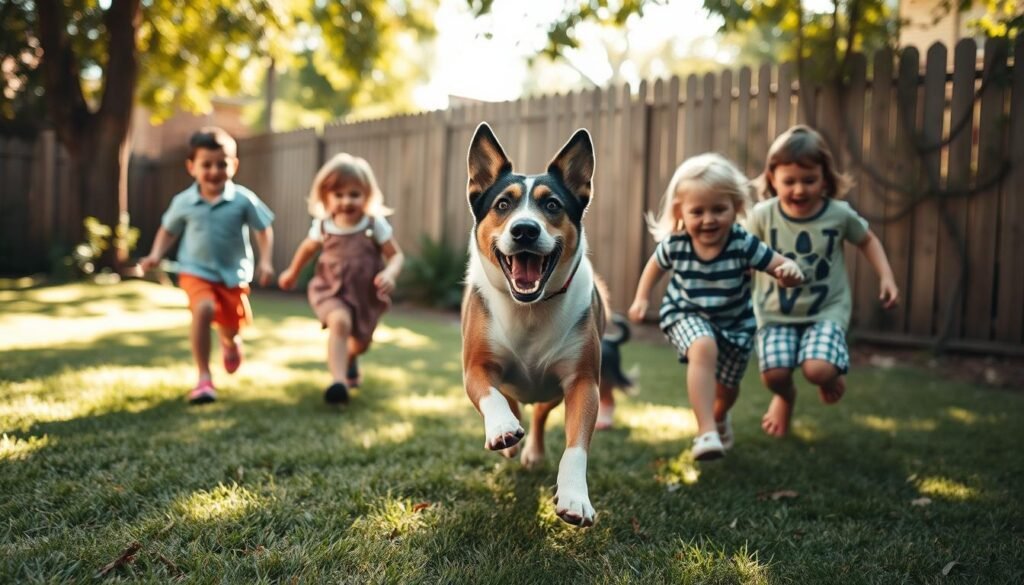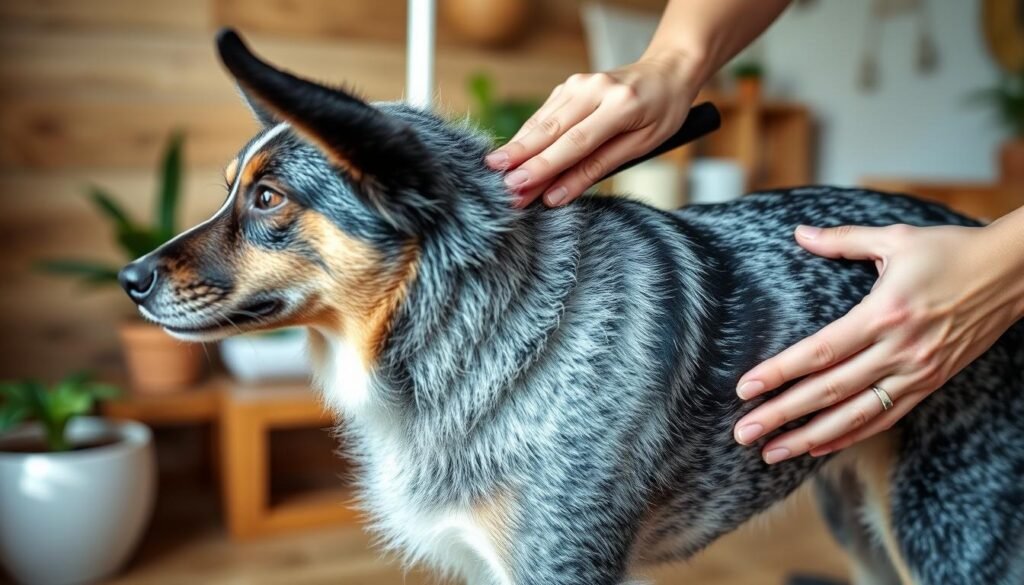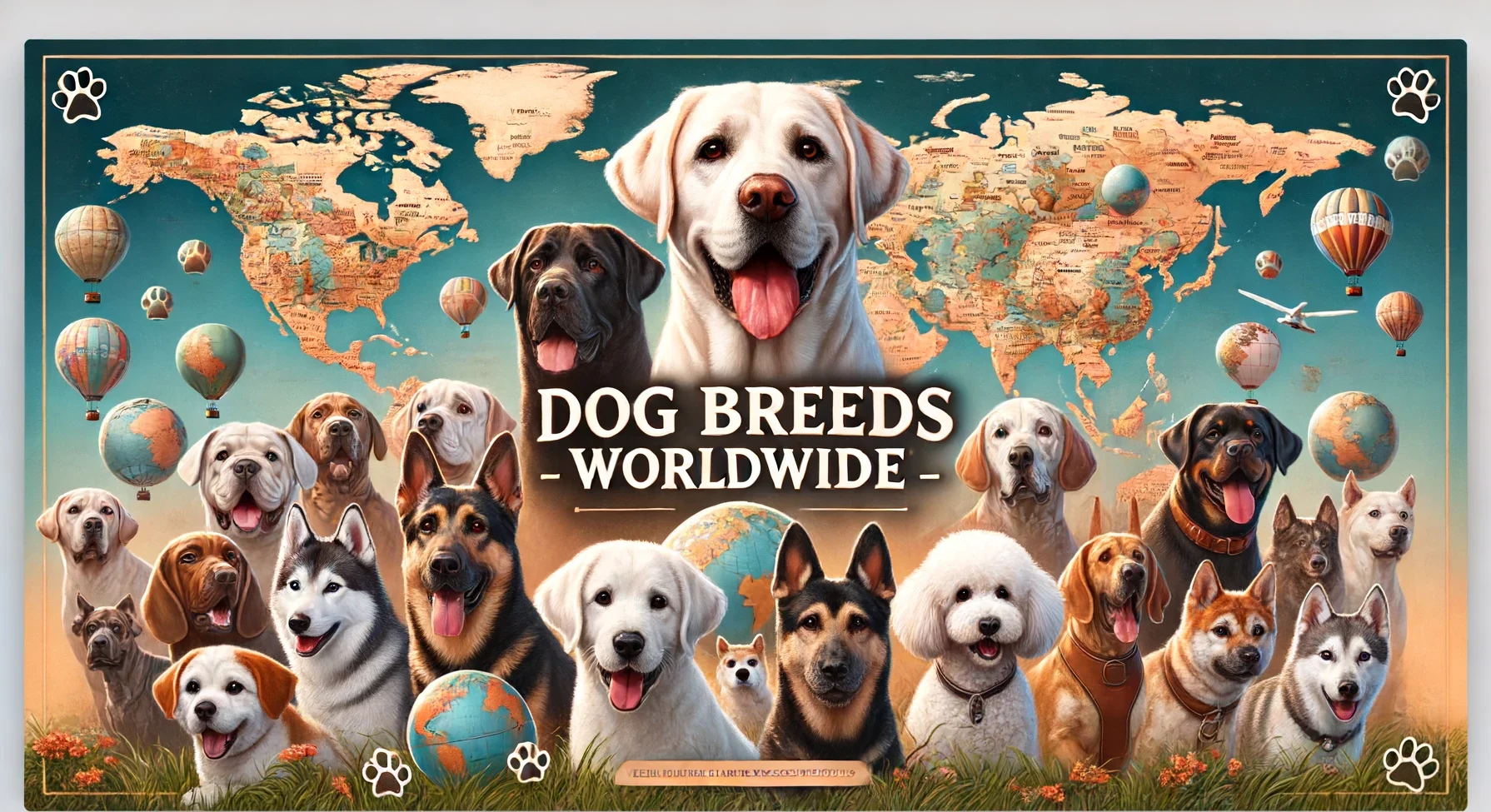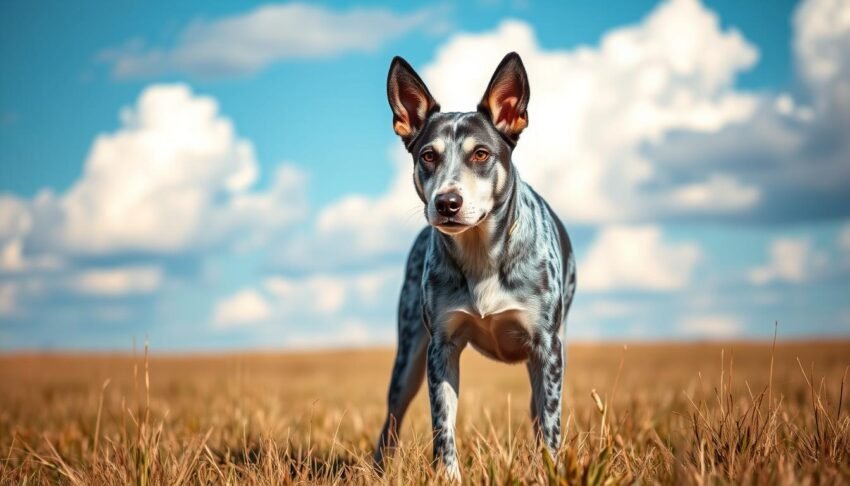The Australian Cattle Dog, also known as the Blue Heeler or ACD, is a special breed. It has a long history in Australia’s farming. They need at least one hour of exercise every day to stay healthy1.
This dog is smart, agile, and works hard. It’s a favorite among farmers and ranchers. They live for 12–15 years on average2.
As a Working Dog and Herding Dog, they are very useful. They have been important in Australian farming for over a century. They come in different colors and patterns because of selective breeding1.
Before getting an Australian Cattle Dog, know they can get sick. They might get eye problems, hip issues, and deafness. They need to see the vet often to stay healthy2.
Despite their health needs, they are very smart and loyal. They love to work and play. They can do agility, obedience, flyball, and tracking1.
Key Takeaways
- The Australian Cattle Dog is a medium-sized breed with a rich history in Australia’s agricultural heritage.
- They require a minimum of one hour of vigorous physical exercise daily to maintain their health and prevent behavioral issues1.
- As a Working Dog and Herding Dog, the Australian Cattle Dog is a versatile breed with a high level of genetic diversity1.
- They have an average lifespan of 12–15 years and are prone to certain genetic conditions2.
- Regular grooming, including weekly brushing, is necessary to maintain their coat’s health and manage seasonal shedding1.
- Early socialization is critical for developing friendly and confident behavior in Australian Cattle Dogs1.
Origins of the Australian Cattle Dog
The Australian Cattle Dog, an Intelligent Breed, started in the early 19th century. This was when cattle farming grew in Australia3. As an Energetic Companion, it was made for the tough Australian outback. It was perfect for ranchers.
The Australian Dog’s history is tied to Australia’s farming past. It was bred to help cattle ranchers4.
To make the Australian Cattle Dog, many dog breeds were mixed. These included the Collie, Dingo, and Dalmatian. They wanted a dog that was smart, full of energy, and could herd cattle3.
Today, this breed is known for its special traits. It has a short, dense coat in many colors, like red and blue5.
Some key traits of the Australian Cattle Dog include:
- Average height: 17-20 inches (43-51 cm)5
- Average weight: 35-50 pounds (16-23 kg)5
- Life span: 12-16 years5
The Australian Cattle Dog is loved for its smarts, energy, and loyalty. It’s a great choice as an Energetic Companion and Intelligent Breed3. With the right training and socialization, it makes a wonderful family pet. It shows off its special qualities as a Cattle Dog Breeds and Australian Dog4.
Key Characteristics of the Breed
The Australian Cattle Dog is a medium-sized dog. It has a sturdy and muscular build. This makes it perfect for herding and Working Dog tasks.
The breed’s coat is short, dense, and weather-resistant. It comes in two main colors: blue or red speckle6. They usually stand 18-20 inches tall and weigh 40-50 pounds. Females are a bit smaller, standing 17-19 inches tall and weighing 35-45 pounds6.
As an Obedient Canine, the Australian Cattle Dog is very smart and loyal. It makes a great friend for farmers and ranchers. The breed is very energetic and needs lots of exercise and mental games to stay happy7.
Some key traits of the breed include:
- High energy level and exercise needs
- High intelligence and trainability
- Loyal and protective nature
- Generally good with children, but can be wary of strangers
As a Herding Dog, the Australian Cattle Dog loves to herd. It might nip if not trained and socialized right6. But with early training and socialization, it becomes a loving family pet.
The Australian Cattle Dog is a unique and special breed. It loves to stay active and mentally sharp. It’s a great choice for those who enjoy the outdoors and are ready to provide the needed exercise and training7.
| Characteristics | Description |
|---|---|
| Size | 18-20 inches tall, 40-50 pounds |
| Coat | Short, dense, and weather-resistant |
| Temperament | Intelligent, loyal, and energetic |
Physical and Mental Exercise Needs
The Australian Cattle Dog is an Energetic Companion. They need lots of exercise to be happy and healthy. They should get at least 1 hour of activity each day, like walking, running, and playing8.
This Intelligent Breed loves to think and learn. They need fun activities like obedience training, agility, and herding trials9.
A Working Dog like the Australian Cattle Dog needs to stay active. This keeps their muscles strong and prevents them from getting too fat. Regular exercise helps them behave well and be calm9.
Some good activities for them are:
- Herding
- Agility
- Nose work
- Rally obedience
As a Herding Dog, they love to work and play. They need lots of exercise and fun activities to stop them from getting bored or acting out8. With enough exercise and play, they make great friends.
| Activity | Duration | Frequency |
|---|---|---|
| Walking | 30 minutes | Daily |
| Running | 30 minutes | 3 times a week |
| Playing | 1 hour | Daily |
Sociability and Family Life
Australian Cattle Dogs are very loyal and protective, making them great family pets10. They might be shy around new people and need to meet many to feel comfortable10. They love rules and knowing what’s expected of them, which helps them behave well10.
They usually get along with kids, but it’s important to watch them together11. They can also live with other pets if they grow up together11. But, they might not always get along with dogs that are too bossy or mean11. They love their family a lot and do well in homes where they get lots of attention and exercise.
Compatibility with Children
It’s key to start teaching an Australian Cattle Dog to be friendly with kids early on10. Training them with treats and praise helps them fit in well with the family11.
Interaction with Other Pets
Australian Cattle Dogs can get along with other pets if they meet them young11. But, they might try to herd them because of their instinct10. They also like to chase small animals, so watching them with other pets is important.

| Age | Socialization Needs |
|---|---|
| 3-5 weeks | Primary socialization |
| 5-16 weeks | Critical socialization |
| 16 weeks and older | Ongoing socialization and training |
Knowing how to socialize Australian Cattle Dogs helps them be happy and loyal10. With the right training and care, they can be a loving part of your family. They show off their skills as a Herding Dog and Obedient Canine.
Training the Australian Cattle Dog
The Australian Cattle Dog is very smart and needs positive training to be good12. They have lots of energy and love to work, like herding13. It’s important to start training and socializing them early11.
Begin with simple commands like “sit,” “stay,” and “come”12. Use treats and praise to help them learn13. Later, you can teach them more, like agility and herding11.
Here are some tips for training your Australian Cattle Dog:
- Be consistent to fix bad behaviors12
- Introduce them to different people, animals, and places13
- Give them lots of exercise, like playing fetch and going for walks11
By using positive training and following these tips, you can build a strong bond with your dog121311.
| Training Method | Description |
|---|---|
| Positive Reinforcement | Using treats and praise to encourage good behavior12 |
| Consistency | Establishing clear communication and addressing unacceptable behaviors13 |
| Socialization | Exposing your dog to various people, animals, and environments11 |
Health Concerns and Lifespan
The Australian Cattle Dog is a Working Dog and Herding Dog. They are usually healthy but can face health problems14. Regular vet visits and care can spot issues early. Common problems include hip dysplasia, eye issues, and deafness14.
Knowing about these health issues helps you care for your dog better. This way, your dog can live a long, healthy life. Australian Cattle Dogs can live up to 29 years with the right care14.
Some key health concerns to be aware of include:
- Hip dysplasia, which can lead to arthritis and mobility issues14
- Progressive retinal atrophy, which can cause blindness14
- Deafness, which can be inherited14
- Dental disease, which can affect up to 80% of dogs by age two15
By knowing about these health issues and preventing them, you can ensure your Australian Cattle Dog lives a long, happy life. They make great Cattle Dog Breeds and Australian Cattle Dog companions15.
| Health Concern | Description |
|---|---|
| Hip Dysplasia | A genetic condition that can lead to arthritis and mobility issues14 |
| Progressive Retinal Atrophy | A condition that can cause blindness14 |
| Deafness | An inherited condition that can affect Australian Cattle Dogs14 |
Feeding and Dietary Requirements
As an owner of an Australian Dog, it’s key to know what they eat. A Herding Dog like the Australian Cattle Dog needs a diet full of protein and fat. They should eat less carbs16. They need 2-3 cups of good dog food each day, split into two meals17.
A Working Dog like the Australian Cattle Dog needs food that gives them lots of energy. Some owners give them raw dog food with extra vitamins and minerals16. Others choose dry food that has the right mix of protein, fat, and carbs17.
Here are some tips for feeding your Australian Cattle Dog:
- 2-3 cups of high-quality dog food per day, divided into two meals17
- A balanced diet that includes protein, fat, and limited carbohydrates16
- Consider adding premium vitamins, minerals, probiotics, and antioxidants to support energy needs16
Talking to your vet is very important to find the best food for your Australian Dog. Their needs change based on their age, size, and how active they are17. A good diet keeps your Obedient Canine happy and healthy.
| Diet Type | Recommended Daily Intake |
|---|---|
| Raw Dog Food | 2-3 cups per day, divided into two meals17 |
| Dry Food | 2-3 cups per day, divided into two meals17 |
Grooming Tips for Australian Cattle Dogs
As an owner of an Australian Cattle Dog, it’s key to know how important grooming is. Their short, dense coat needs regular brushing to avoid mats and tangles. They shed moderately all year, but more in spring and fall18. Brushing them two to four times a week keeps their coat in good shape18.
To keep your Australian Cattle Dog clean, brush their coat often. Aim for two to four times a week18. This helps cut down on shedding and mats. Also, bathe them every couple of months or more if they get dirty18. Don’t forget to clean their teeth and ears regularly to keep them healthy18.
Coat Care and Maintenance
Brushing can really help with shedding and loose hair18. Use de-shedding tools during seasonal changes to manage shedding18. Their coat is smooth and double-layered, in red or blue speckled colors18. Some owners also use slicker brushes and dog combs19.

Bathing Frequency
Australian Cattle Dogs don’t need baths often. They need them every couple of months or more if they get dirty18. Regular brushing and grooming can keep them clean and reduce shedding19. By following these tips, you can keep your Australian Cattle Dog clean and happy18.
Living Environment Suitability
Living with an Australian Dog needs careful thought about their space and where they like to be20. As a Herding Dog, they love to run and explore. They do best in homes with big yards21. But, they can also live indoors if they get enough exercise and fun20.
Australian Cattle Dogs are smart and easy to train22. They need lots of physical activity every day22. This makes them perfect for people who love to stay active20.
These dogs can live in both country and city homes20. But, they always need daily play and brain work20. A mix of indoor and outdoor living is great for them. It gives them the social time and exercise they love20.
| Living Environment | Suitability Rating |
|---|---|
| Active owners and families | Excellent20 |
| Experienced dog owners | Good20 |
| Urban dwellers | Fair20 |
| Seniors or less active individuals | Limited20 |
The right home for an Australian Cattle Dog depends on their needs and your care22. With the right care, these Working Dogs can do well in many homes21.
Fun Activities with Your Australian Cattle Dog
The Australian Cattle Dog is an Intelligent Breed and Energetic Companion. They need lots of fun activities to stay happy and healthy23. They love long walks, runs, bike rides, hikes, and playing at dog parks23.
They enjoy agility classes, rally obedience, and flyball training23. Interactive toys and games keep them busy and happy23.
Being a Herding Dog, they love to move and work. They fit well with active families who can give them lots of exercise and training11. Positive training methods, like clicker training, help them be good and loyal11.
The Australian Cattle Dog is great for active families. They need lots of physical and mental play to be happy242311.
Why Choose an Australian Cattle Dog?
If you want a loyal, smart, and very active friend, the25Australian Cattle Dog is great. They are good at herding and have special qualities. These make them great for people and families who like to stay active.
The Australian Cattle Dog is tall, between 17 to 20 inches25. They weigh 35 to 50 pounds25. They live a long time, 12 to 16 years, and sometimes up to 20 years25. The oldest dog ever was an Australian Cattle Dog named Bluey, who lived 29 years and 5 months25.
These dogs are very athletic and smart. They love to learn and please their owners. They do well in dog sports like obedience and agility26. But, they need lots of training and exercise to stay happy and well-behaved.
Having an Australian Cattle Dog is rewarding but it’s a big job27. They need regular grooming to keep their thick coat clean25. They also need lots of mental and physical activity, at least 1 to 2 hours a day26.
In short, the Australian Cattle Dog is a special and versatile breed. If you’re ready to give them the time and effort, they could be a wonderful addition to your family.
FAQ
What is the origin of the Australian Cattle Dog?
What are the key characteristics of the Australian Cattle Dog?
How much exercise do Australian Cattle Dogs need?
How do Australian Cattle Dogs interact with children and other pets?
What health concerns are common in Australian Cattle Dogs?
What are the grooming requirements for an Australian Cattle Dog?
What type of living environment is best for an Australian Cattle Dog?
What fun activities can I do with my Australian Cattle Dog?
Source Links
- Australian Cattle Dog: Versatile, Energetic And Loyal Breed – https://bonevoyagedogrescue.com/australian-cattle-dog-your-adventure-buddy/
- Australian Cattle Dog: Energetic and Loyal Herding Partner – https://www.dogpackapp.com/blog/dog-breeds/australian-cattle-dog/
- Australian Cattle Dog – https://en.wikipedia.org/wiki/Australian_Cattle_Dog
- The real origins of Australia’s famous cattle dog – https://www.abc.net.au/news/2018-10-25/history-of-the-australian-cattle-dog/10390626
- Australian Cattle Dog | Description, Temperament, Images, & Facts | Britannica – https://www.britannica.com/animal/Australian-cattle-dog
- Australian Cattle Dog Breed Information & Characteristics – https://dogtime.com/dog-breeds/australian-cattle-dog
- Learn About the Loyal Blue Heeler (Australian Cattle Dog) – https://www.thesprucepets.com/blue-heeler-4176567
- Guide to the Heeler or Australian Cattle Dog | Pet Parenting – https://www.trupanion.com/pet-blog/article/australian-cattle-dog
- How Much Exercise Does a Australian Cattle Dog Need? – https://iheartdogs.com/how-much-exercise-does-a-australian-cattle-dog-need/
- Sharing your life with an ACD (Australian Cattle Dog) – https://madeleinwolf.medium.com/sharing-your-life-with-an-acd-australian-cattle-dog-587a420cf9e4
- Living with an ACD | acdra – https://www.acdra.org/living-with-an-acd
- Blue Heeler Training | Tips from a Boulder Dog Trainer – https://blackpawdogtraining.com/blue-heeler-training-tips/
- How to Train Australian Cattle Dog: Step-by-Step Guide – https://blog.tryfi.com/how-to-train-australian-cattle-dog/
- Australian Cattle Dog – https://www.petmd.com/dog/breeds/australian-cattle-dog
- Breed Info – Fruitville Veterinary Clinic – https://fruitvillevet.com/client-resources/breed-info/australian-cattle-dog-2/
- Australian Cattle Feeding Guide – https://www.prodograw.com/raw-feeding-guide/australian-cattle-feeding-guide/
- Australian Cattle Dog diet. | Dog Food Advisor – https://www.dogfoodadvisor.com/forums/topic/australian-cattle-dog-diet/
- How to Groom an Australian Cattle Dog: 8 Great Tips – Dogster – https://www.dogster.com/dog-health-care/how-to-groom-an-australian-cattle-dog
- How I keep a clean home… with an Australian cattle dog – https://www.pawsandreflect.blog/p/how-i-keep-a-clean-home-with-an-australian-cattle-dog
- Suitability of the Australian Cattle Dog for Different Types of Owners – https://puppylist.com.au/breeds/australian-cattle-dog/suitability/
- Is an Australian Cattle Dog right for your family? – https://www.greencrossvets.com.au/pet-library/breed-guide/dog/is-an-australian-cattle-dog-right-for-your-family/
- Life With A Cattle Dog 101 Owner’s Perspective – https://bonevoyagedogrescue.com/cattle-dog/
- How to Keep Your Herding Dog Active | AKC Pet Insurance – https://www.akcpetinsurance.com/blog/herding-dogs-how-to-keep-your-highenergy-shepherd-or-cattle-dog-active-when-theyre-not-working
- Top Activities For Australian Cattle Dogs – Wag! – https://wagwalking.com/activity/activities-for-australian-cattle-dogs
- Four Reasons Why Australian Cattle Dogs Are the Best Family Dog – https://neaterpets.com/blogs/news/australian-cattle-best-family
- Australian Cattle Dogs: The Ultimate Herding Companion – https://www.zealandiapets.com/pages/australian-cattle-dogs-the-ultimate-herding-companion?srsltid=AfmBOoqKCz2tHLz3VhLH5VMTWFTTc97x92olTz2nGHXvlA45HFn5fhJg
- Australian Cattle Dogs … what’s your experience? – https://www.dogforum.com/threads/australian-cattle-dogs-whats-your-experience.242553/


